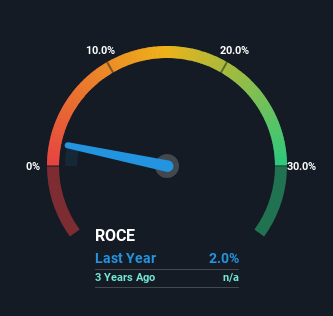Returns On Capital At Atrato Onsite Energy (LON:ROOF) Have Stalled
What trends should we look for it we want to identify stocks that can multiply in value over the long term? One common approach is to try and find a company with returns on capital employed (ROCE) that are increasing, in conjunction with a growing amount of capital employed. Basically this means that a company has profitable initiatives that it can continue to reinvest in, which is a trait of a compounding machine. Although, when we looked at Atrato Onsite Energy (LON:ROOF), it didn't seem to tick all of these boxes.
Understanding Return On Capital Employed (ROCE)
For those that aren't sure what ROCE is, it measures the amount of pre-tax profits a company can generate from the capital employed in its business. To calculate this metric for Atrato Onsite Energy, this is the formula:
Return on Capital Employed = Earnings Before Interest and Tax (EBIT) ÷ (Total Assets - Current Liabilities)
0.02 = UK£2.8m ÷ (UK£141m - UK£419k) (Based on the trailing twelve months to March 2023).
Thus, Atrato Onsite Energy has an ROCE of 2.0%. In absolute terms, that's a low return and it also under-performs the Electrical industry average of 10%.
View our latest analysis for Atrato Onsite Energy

In the above chart we have measured Atrato Onsite Energy's prior ROCE against its prior performance, but the future is arguably more important. If you'd like, you can check out the forecasts from the analysts covering Atrato Onsite Energy here for free.
What Does the ROCE Trend For Atrato Onsite Energy Tell Us?
Over the past , Atrato Onsite Energy's ROCE and capital employed have both remained mostly flat. Businesses with these traits tend to be mature and steady operations because they're past the growth phase. So don't be surprised if Atrato Onsite Energy doesn't end up being a multi-bagger in a few years time. On top of that you'll notice that Atrato Onsite Energy has been paying out a large portion (67%) of earnings in the form of dividends to shareholders. These mature businesses typically have reliable earnings and not many places to reinvest them, so the next best option is to put the earnings into shareholders pockets.
The Key Takeaway
We can conclude that in regards to Atrato Onsite Energy's returns on capital employed and the trends, there isn't much change to report on. And in the last year, the stock has given away 22% so the market doesn't look too hopeful on these trends strengthening any time soon. Therefore based on the analysis done in this article, we don't think Atrato Onsite Energy has the makings of a multi-bagger.
One final note, you should learn about the 3 warning signs we've spotted with Atrato Onsite Energy (including 1 which doesn't sit too well with us) .
While Atrato Onsite Energy may not currently earn the highest returns, we've compiled a list of companies that currently earn more than 25% return on equity. Check out this free list here.
Have feedback on this article? Concerned about the content? Get in touch with us directly. Alternatively, email editorial-team (at) simplywallst.com.
This article by Simply Wall St is general in nature. We provide commentary based on historical data and analyst forecasts only using an unbiased methodology and our articles are not intended to be financial advice. It does not constitute a recommendation to buy or sell any stock, and does not take account of your objectives, or your financial situation. We aim to bring you long-term focused analysis driven by fundamental data. Note that our analysis may not factor in the latest price-sensitive company announcements or qualitative material. Simply Wall St has no position in any stocks mentioned.

 Yahoo Finance
Yahoo Finance 